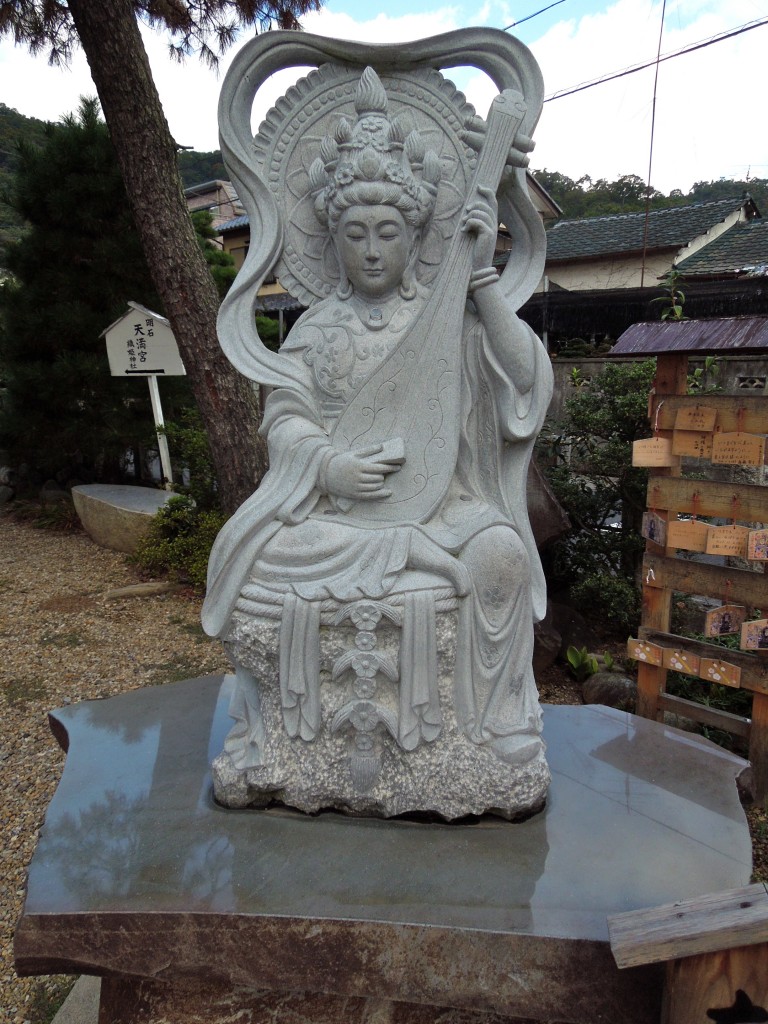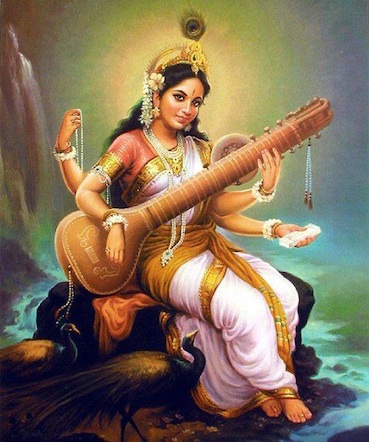 She stands seductively at the water’s edge and speaks of poetry and music. In her hands a lute, and around her feet white snakes coiled in attendance. She brings good fortune to those who worship her, and she sails the high seas with a jolly crew of seven. She’s a goddess, a deity, a Muse. She’s Benzaiten, aka Benten, honoured by Shinto and Buddhism alike.
She stands seductively at the water’s edge and speaks of poetry and music. In her hands a lute, and around her feet white snakes coiled in attendance. She brings good fortune to those who worship her, and she sails the high seas with a jolly crew of seven. She’s a goddess, a deity, a Muse. She’s Benzaiten, aka Benten, honoured by Shinto and Buddhism alike.
If you see a shrine on an islet, in all likelihood it will be that of Benten. In the midst of the pond garden, or haunting islands along the coast, it is Benten. Water is her medium, and the subconscious her realm. Benten moves in mysterious ways, like the wavy patterns of her dress. She’s an artist, who possesses knowledge of the hidden world and speaks to the eternal. She’s a higher truth in human form.
In a posting for her blog, Anuradha Gupta has written of the origins of this compelling deity, who made her way from ancient India across the vast expanse of China from where she passed into Japan sometime between the sixth and eighth centuries. To understand her spell, you have to travel back in time to the origins. Back indeed to holy Saraswati, incarnation of the river that feeds the well-springs of creativity within us all… (the piece below is an edited version; for the original, click here.)
******************************************************************
Saraswati is one of the three main Hindu goddesses. She is ‘Vac Devi’, the goddess of ‘speech’ or literature and is incarnated in all art forms. All knowledge and learning is believed to flow from Saraswati. While Brahma is the Lord of Creation, Saraswati his daughter is Creativity itself.
You can recognize her by her white and gold garments and pale complexion. She has four arms and holds in her hands the veena, a stringed musical instrument, a book ( the vedas), a mala of beads and sometimes a pot of water. She is often seen seated on a lotus flower or standing by a river. At times you will find peacocks or swans by her side.
 Meaning and Origin Saraswati means ‘to flow’, as is the nature of knowledge and creativity. It cannot be contained and must flow freely. Saraswati is also the Goddess of Purity, for the true purpose of knowledge is to purify the mind and lead it to wisdom. It is also the nature of a river to flow, to purify and to nourish. And, ultimately to merge with the ocean.
Meaning and Origin Saraswati means ‘to flow’, as is the nature of knowledge and creativity. It cannot be contained and must flow freely. Saraswati is also the Goddess of Purity, for the true purpose of knowledge is to purify the mind and lead it to wisdom. It is also the nature of a river to flow, to purify and to nourish. And, ultimately to merge with the ocean.
No surprise then that the Goddess Saraswati as we know her today started off as the Rig Vedic river, Saraswati, which once flowed from the East to the West in northern India. Today only a small part of it remains as the Ghaggar River in Rajasythan; the rest of it long lost under the vast Marusthali desert.
However satellite images and geological mapping show that the Vedic Saraswati was indeed an enormous river, about 1500 kms long and eight kms wide in her prime. Archeologists believe she played a major role in sustaining the Indus Valley civilization. Which explains why Saraswati is praised so lavishly in all the Vedas with several hymns dedicated to her. One hymn describes her as the ‘best of the mothers, best of the rivers, best of the goddesses’. The river was an important part of all Vedic worship and rituals and continues to be an integral part of Hinduism even today.
Around 4000 BC when the Saraswati dried up, the people who had settled on her banks moved eastwards. Thousands of years later, by the time the Upanishads and Puranas were written, the River Ganges had become the most important river and the Saraswati had faded into a memory preserved in myths and stories.
This transformation in attitudes is clearly seen in the Upanishads wherein Saraswati now becomes the goddess of knowledge who leads man to the ocean of Truth. This idea of Saraswati was later incorporated into Jainism and Buddhism. Through Buddhism it spread beyond India to the far east.
In Jainism, she became Saraswati, the dispeller of darkness and ignorance. Tibetan Buddhists know her as Yang Chenmo who bestows wisdom and learning. In Mongolian she is Keleyin ukin Tegri, in Chinese she is called Tapien-ts’ai t’iennu or Miao-yin mu, and in Japan she is Dai-Ben-Zai-Ten, meaning ‘the great divinity of the reasoning faculty’.
***************************************************************************
Benzaiten as a kami (From Wikipedia)
Benzaiten is a female kami to Shinto with the name Ichikishima-hime-no-mikoto. Also, she is believed by Tendai Buddhism to be the essence of kami Ugajin, whose effigy she sometimes carries on her head together with a torii. As a consequence, she is sometimes also known as Uga Benzaiten or Uga Benten.
The three big Benzaiten shrines in Japan are at Enoshima Island in Sagami Bay, the Chikubu Island in Lake Biwa and the Itsukushima Island in Seto Inland Sea.

I wonder if the coiled white serpent we often see in mountains shrines are representations of Benzaiten. They can be found near waterfalls as well, which makes sense as the form of a waterfall looks like a white snake.
Thanks for the thought, Ted, and thanks for reporting back on mountain shrines, which I unfortunately don’t get to as often as you… White snakes are a potent symbol of purity and vitality, and in this respect I imagine that there’s a close connection with the Naga of Hinduism that may go back to roots beyond Benzaiten. It’s said for instance the snake cult at Omiwa predates the installation of kami there by the Yamato. Given those mountain shrines might be honouring ancient traditions, perhaps it’s more animism than Bentenism…